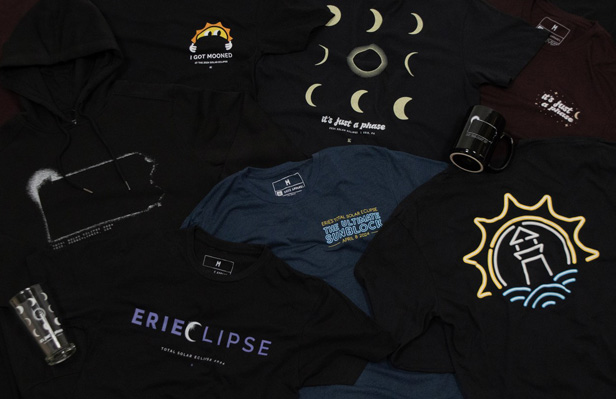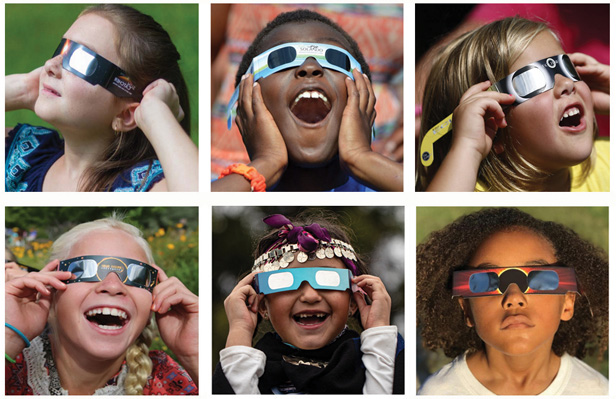Product Hub April 02, 2024
Eclipse-Themed Products Come Out of the Shadows
In advance of the April 8 North American solar eclipse, promotional products companies have been hard at work stocking up on viewing glasses and other themed merch.
The solar eclipse’s point of totality will only last mere minutes on Monday, April 8, but hype around the phenomenon has been anything but short-lived.
This opportunity comes once in a blue moon for spectators, as the contiguous U.S. won’t be in a path of totality until 2044. And even then, only a lucky few in Montana and North Dakota will bear witness.
This is the last total solar eclipse that’s going to cross the path of the U.S. for the next 20 years,” says American Astronomical Society Press Officer Susanna Kohler. “It’s really an exciting opportunity for folks in the U.S. to get to see a really spectacular phenomenon.”
American Paper Optics (asi/35591) expects to sell 75 million pairs of its ISO-certified eclipse-viewing glasses this year. (photo courtesy of American Paper Optics)
Sales of products surrounding the solar spectacle have far eclipsed expectations. ESP searches for “eclipse” and “eclipse glasses” began to notably increase in June 2023, with average monthly searches for those terms rising more than 400% in the second half of 2023, compared to the 15 months prior. In the first quarter of 2024, searches peaked at a 2,800% increase, compared to the 15 months prior to when searches for the two terms first began to climb.
The eclipse will spur over $6 billion in direct and indirect economic impact nationwide, according to Barron’s. For promotional products suppliers, capitalizing on this mass interest meant starting work months, or even years, ahead of April 8.
American Paper Optics (asi/35591), founded in 1990, is the world’s largest manufacturer of eclipse glasses. The Memphis-based supplier sold over 45 million glasses for the last total eclipse in 2017, and sales are expected to reach 75 million pairs this year, according to Chief Marketing Officer Jason Lewin.
“On our e-commerce platform, we were used to getting 10, 15, 20 orders a day. Well, that went up to close to 13,000 orders a day [in 2017],” Lewin says. “We learned from that, and we spent the next seven years prepping for this one.”
About half of American Paper Optics’ eclipse glasses have been directly sold as promo products this year, Lewin estimated. He names NASA, St. Jude and Warby Parker as buyers, in addition to school districts, universities and museums.
Local governments, specifically for the towns located in the eclipse’s path of totality (where the moon will completely block the sun), have also commissioned eclipse merchandise.
VisitErie, the Pennsylvania town’s tourism agency, partnered with a local outfitter to sell commemorative T-shirts, hoodies, drinkware and glasses. Alongside state and solar outlines, merchandise features tongue-in-cheek phrases like, “It’s Just a Phase” and “I Got Mooned!” or the commemorative moniker, “Erieclipse.”

The tourism agency of Erie, PA, partnered with a local retailer to offer eclipse merchandise. (photo courtesty of Erie Apparel)
Erie Apparel Owner Greg Straub says he was “actually shocked” by the consumer response to the merchandise. The town of Erie is expecting over 200,000 visitors for the eclipse, and both out-of-towners and locals have snapped up the merchandise, Straub says.
“Especially for a retail business like ours, the first quarter of the year is usually seeing dust bunnies blow by. Everybody’s done with their heavy spending in the Christmas season,” Straub says. “This has been a very welcome boost. It’s far exceeded a lot of our hot market items over the years in terms of popularity.”
Widespread interest in eclipse-themed products has also spurred precautions. Eclipse glasses, an essential item for viewing the eclipse outside of totality, must be manufactured with a certified level of eye protection. Some products have been found not to meet those standards, according to Kohler.
The American Astronomical Society has identified cases of both counterfeit and fake glasses, which fail to effectively block out dangerous light frequencies, on the market. Effective eclipse glasses should be more than 1,000 times darker than regular sunglasses, Kohler says.
“There is a real risk if you’re getting your solar eclipse glasses from a source that you don’t trust, that isn’t verified, of getting something that is unsafe and could lead to you damaging your eyes,” Kohler says.
Those looking to verify their eclipse glasses can visit the AAS’ list of reputable sellers. Given the difficulty of vetting all manufacturers, Kohler says there may be some gaps on the list; however, the AAS verification is a reliable mark of safety.
To check if glasses are unsafe, Kohler advised users to test them both indoors and outdoors. “If you put on your glasses inside, and you look around, it should be very boring. You shouldn’t see anything,” she says. “If you look outside, you should not be able to see anything. Except, if you’ve done that test and if you can’t see anything through those glasses, if you look briefly at the sun, you should be able to see the sun. But it should look like a dim disk that is comfortable to look at.”
American Paper Optics branding has been used in counterfeited glasses, Lewin says, which pose a significant safety risk. All APO glasses are ISO certified, and the company is an AAS verified seller.
To verify “APO” glasses purchased indirectly by a reputable American vendor, Lewin says to check that APO’s name and address, manufacturer directions and ISO certification are printed on them. The lenses should also be tested, as Kohler recommends, and be free of any rips or tears.
Given the 32 million Americans who live in the path of totality – plus the millions who will flock there – Lewin emphasizes the magnitude of taking the necessary safety precautions. And with a two-decade timeline until the next U.S.-viewable eclipse, he called the eclipse a “once-in-a-lifetime opportunity.”
“It’s a nationwide event that everybody’s going to take part in,” Lewin says.

Product Hub
Find the latest in quality products, must-know trends and fresh ideas for upcoming end-buyer campaigns.

